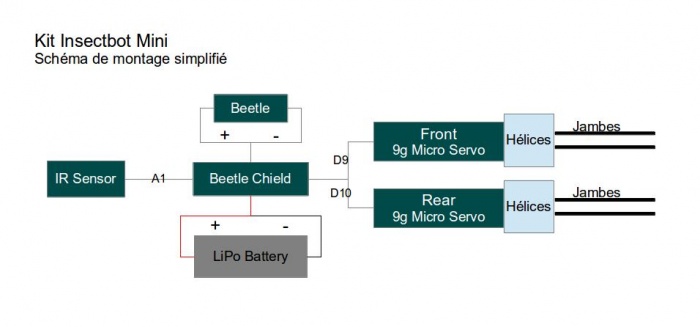Insect bot
De Wikidebrouillard.
(→Réalisation du projet) |
(→Réalisation du projet) |
||
| Ligne 37 : | Ligne 37 : | ||
==Réalisation du projet== | ==Réalisation du projet== | ||
| + | |||
| + | ===Schéma=== | ||
| + | [[Image:Schema_kit_insectbot.jpg|700px]] | ||
| + | |||
===Assemblage=== | ===Assemblage=== | ||
/* ♥ LE GROUPE DES FILLES REMPLIE ICI ♥ */ | /* ♥ LE GROUPE DES FILLES REMPLIE ICI ♥ */ | ||
http://www.instructables.com/id/Insect-Bot-mini/ | http://www.instructables.com/id/Insect-Bot-mini/ | ||
| - | |||
| - | === | + | ===Chargement du programme=== |
| - | + | ||
===Code=== | ===Code=== | ||
Version du 3 juillet 2014 à 17:50
Sommaire |
Présentation du projet Insectbot
Robot électromécanique avec senseur infrarouge à monter en kit, créer en Chine par Lutz Michaelis, sur cet atelier nous utilisons la version distribué par DFRobot. https://www.facebook.com/lumi3005
Robot électromécanique avec senseur infrarouge à monter en kit, créer en Chine par Lutz Michaelis, sur cet atelier nous utilisons la version distribué par DFRobot. https://www.facebook.com/lumi3005
Animateur:
Habib https://www.facebook.com/groups/bbmakers/
Participants:
Claude, Thierry, Igor, Olivier,
Liste du matériel
DIY Kit Insectbot Mini de DFRobot [1]
Les références indiqués sont celles du vendeur DFRobot
- [[Image:|50px]] 1x Carte DFRobot Beetle Arduino
- [[Image:|50px]] 1x Carte DFRobot Beetle Shield v0.4
-
 2x Micro Servomoteur SG90 (ref:SER006)
2x Micro Servomoteur SG90 (ref:SER006)
- 1x Senseur Infrarouge Sharp 2YOPA21 (ref:SEN0014)
- 1x Batterie LiPo 3.7V/180mAh avec un chargeur USB
- 2x Tiges Acier 200mm x 1mm
- 1x Feuille de plastique de 50 x 50mm
- 1x scotch double face 40x30mm
- 5x colliers serflex 100mm
- 1x collier serflex 200mm
-

 Un ordinateur et le logiciel Arduino pour charger le programme
Un ordinateur et le logiciel Arduino pour charger le programme
Réalisation du projet
Schéma
Assemblage
/* ♥ LE GROUPE DES FILLES REMPLIE ICI ♥ */ http://www.instructables.com/id/Insect-Bot-mini/
Chargement du programme
Code
// /////////////////////////////////////////////////////////////////
// INSECT BOT MINI //
// //
// modified by Lumi for DFRobot.com //
// 2013/10/26 //
////////////////////////////////////////////////////////////////////
// Servo Library
#include <Servo.h>
// Servo name
Servo frontServo;
Servo rearServo;
// time delay between steps
int walkSpeed = 500;
// center servos
int centerPos = 90;
// servo angles for walking pattern
int frontRightUp = 70;
int frontLeftUp = 110;
int backRightForward = 70;
int backLeftForward = 110;
// another center position
int centerTurnPos = 81;
// servo angles for walking pattern
int frontTurnRightUp = 70;
int frontTurnLeftUp = 110;
int backTurnRightForward = 70;
int backTurnLeftForward = 110;
// variable for distance value
int distance = 0;
// average distance value
int distanceCheck = 0;
// Array for distance values
int collectDistance[5];
// Variables for counters
int i;
int f;
int r;
// assign analog pin A1
int sensorPin = A1;
// distance value for danger close. Bigger values are greater distance and smaller values are lower distance
int dangerDistance = 350;
/* Setup function */
void setup()
{
// attach servos
frontServo.attach(9);
rearServo.attach(10);
// assign sensor
pinMode(sensorPin, INPUT);
// center servos
frontServo.write(centerPos);
rearServo.write(centerPos);
// wait 3 seconds for start walking
delay(3000);
//Serial.begin(9600); // serial data setup
}
/* distance check function */
void scan()
{
// read 5 distance values
for (i = 0; i < 5; i = i + 1) {
distanceCheck = analogRead(sensorPin);
collectDistance[i] = distanceCheck;
// serial output for testing
//Serial.print (i);
//Serial.print(" = ");
//Serial.println(collectDistance[i]);
}
// checksum of the 5 distance values for getting an average value. This will prevent the robot to change behavior by reading one wrong value
distance = (collectDistance[0]+collectDistance[1]+collectDistance[2]+collectDistance[3]+collectDistance[4])/5;
delay(20);
}
// walk forward
void moveForward()
{
// loop for the servo angels to smoothen the steps
for (f = 0; f < 39; f++){
frontRightUp++;
backLeftForward--;
frontServo.write(frontRightUp);
rearServo.write(backLeftForward);
delay(10);
}
// loop for the servo angels to smoothen the steps
for (r = 0; r < 39; r++){
frontRightUp--;
backLeftForward++;
frontServo.write(frontRightUp);
rearServo.write(backLeftForward);
delay(10);
}
}
// walk backwards to the left
void moveBackRight()
{
frontServo.write(frontRightUp);
rearServo.write(backRightForward-6);
delay(110);
frontServo.write(centerPos);
rearServo.write(centerPos-6);
delay(80);
frontServo.write(frontLeftUp+9);
rearServo.write(backLeftForward-6);
delay(110);
frontServo.write(centerPos);
rearServo.write(centerPos);
delay(80);
}
// walk forward to the left
void moveTurnLeft()
{
frontServo.write(frontTurnRightUp);
rearServo.write(backTurnLeftForward);
delay(110);
frontServo.write(centerTurnPos);
rearServo.write(centerTurnPos);
delay(80);
frontServo.write(frontTurnLeftUp);
rearServo.write(backTurnRightForward);
delay(110);
frontServo.write(centerTurnPos);
rearServo.write(centerTurnPos);
delay(80);
}
// blink LED. This function can be called in any situation you want. Just add led(); in the code where you want to blink the LED.
void led(){
// loop for the LED to blink it 5 times for 0.05 sec on and 0.1 sec off
for(int l=0; l<=5; l++) {
digitalWrite(13, HIGH);
delay(50);
digitalWrite(13, LOW);
delay(100);
}
}
// that's the loop. This is repeatedly called as long as the robot is powered on
void loop()
{
// call function for checking the distance
scan();
//Serial.println(distance);
if (distance > 1){ // filters out the zero readings
// an obstacle is being detected
if (distance > dangerDistance) {
// LED at Pin 13 (standard) blinks 5x
led();
// 4 steps backward left
for(int i=0; i<=3; i++) {
moveBackRight();
delay(walkSpeed);
}
// 4 steps forward left
for(int i=0; i<=3; i++) {
moveTurnLeft();
delay(walkSpeed);
}
} else {
// all clear, no obstacle detected. Just walk forward
moveForward();
delay(walkSpeed/100);
}
}
}
Liens avec d'autres projets arduino
chercher ici : http://wikidebrouillard.org/index.php/Catégorie:Arduino
Pour aller plus loin
Liens avec le quotidien
quelles peuvent être les applications technologiques de ce montage, ou est-ce qu'on retrouve des programmes qui y ressemble ?


